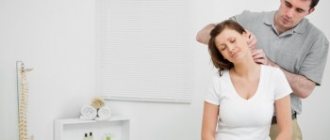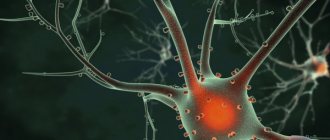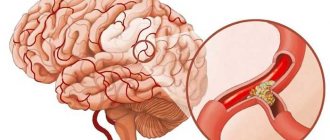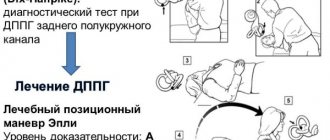The autonomic nervous system is responsible for the normal functioning of internal organs: heart, blood vessels, gastrointestinal tract, respiratory system. Therefore, when its functioning is disrupted, a wide variety of manifestations can occur, including panic attacks, a feeling of lack of air, and pain in the heart. Breathing exercises for vegetative-vascular dystonia (VSD) will help normalize disturbed processes and improve well-being.
Why is breathing exercise useful for VSD?
Autonomic vascular dystonia is a functional disorder in which the structure of the organ does not suffer, but only the regulation of its work is disrupted. This condition is provoked by stress, mental stress, increased physical or emotional stress.
Translated from Latin, “vegeto” means excitement. During attacks of VSD, “vascular excitation” occurs: blood pressure rises and falls, a feeling of lack of air appears, the heartbeat quickens, and dizziness occurs. Various fears (panic attacks) are also characteristic, ranging from the fear of death to the fear of speaking (also known as glossophobia).
It is during such attacks that breathing exercises are of great importance. It allows you to find the correct breathing rhythm so that the blood is saturated with oxygen, the feeling of shortness of breath disappears, and the heart begins to beat more slowly. Also, respiratory exercises help to distract from worries and fears - and the attack gradually passes.
Breathing according to Strelnikova
It is not a specially developed medical set of exercises. The effectiveness of this exercise has not been proven in clinical trials. But, according to reviews from many patients, such gymnastics helps to significantly improve the condition and reduce the frequency of attacks during VSD.
In addition to the calming effect during VSD, this set of breathing exercises allows you to improve nasal breathing and lung ventilation, improves vascular tone, and helps improve posture.
A set of breathing exercises for VSD according to Strelnikova:
- I.p. standing straight, arms bent at elbows at shoulder level, palms turned away from you. Elbows are not pressed to the body. A short inhale through the nose is accompanied by clenching of the palms, and exhalation through the mouth is accompanied by straightening of the fists. Take 8 such breaths, then a five-second pause and another round of exercises. It is better to start gymnastics with this warm-up exercise.
- I.p. standing, arms pressed to the body, fists clenched. Inhale through your nose, lower your arms lower, tense your shoulders, unclench your fists, spreading your fingers as far as possible. While inhaling, return to I.p. repeat 8 times, then take a 3-second break and repeat the exercise.
- I.p. standing, legs wider than shoulders, arms at chest level, elbows bent, palms facing each other. When you try to hug yourself by the shoulders, take a breath. When you straighten your arms to the sides, exhale. Do 8 breathing cycles, then take a break for a few seconds. In total you need to perform 12 approaches.
Why do you need breathing exercises?
Performing a set of breathing exercises for VSD is necessary to solve several problems:
- Stabilization of heart function;
- Restoring the rhythm of breathing;
- Suppressing anxiety and fear;
- Normalization of blood pressure;
- Blood oxygen saturation;
- Stopping dizziness;
- Increasing the tone and endurance of the body.
Classes do not have to be carried out only during a panic attack. During the interictal period, they have a preventive value and make the nervous system more resistant to stress.
Gym
You can go to the gym. In this case, it is necessary to ensure that the load level corresponds to the general condition. Otherwise, dysfunction of the ANS is possible, which manifests itself:
- blood pressure fluctuations;
- increased heart rate;
- increased sweating;
- tremor of the upper extremities.
With the correct approach, weight training helps improve the state of the autonomic nervous system, relax muscles, and reduce the concentration of stress hormones.
Primary requirements:
- You need to work with weights until slight fatigue appears. Range – 12-15 repetitions;
- avoid performing exercises in which the head is below the level of the pelvis;
- don't hold your breath. Otherwise, blood pressure will begin to “jump”;
- Do not change your body position too abruptly. Otherwise, dizziness will occur;
- Use only single-joint, local exercises in training.
In addition to weight training, the weekly cycle should include aerobic exercise.
Breathing exercises
In everyday life, we rarely pay attention to how we breathe. But proper breathing is a whole science that requires special study and long-term training. In order for breathing movements to become as effective as possible, it is necessary to master the techniques of diaphragmatic, abdominal, thoracic, deep and shallow breathing.
Breathing and vegetative-vascular dystonia
The appearance of shortness of breath during an attack of VSD is not a sign of a disease of the respiratory system, but only an inadequate reaction of the nervous system to a mental stimulus. Nevertheless, for the patient this condition is extremely unpleasant: he develops a feeling of inadequacy of inhalation and a fear of death.
Note!
If the attack is truly caused by VSD, and all examinations of the heart and lungs do not reveal pathology, then a person has no real risk of dying during a panic attack. Loss of consciousness may occur due to fluctuations in blood pressure or vasospasm. But the mechanisms of breathing regulation work automatically in the body, so it is impossible to suffocate in such a situation.
The most important thing that a patient with VSD must learn is to calm down on his own. And measured breathing helps him with this. It distracts from groundless worries and fears, saturates the blood with a large amount of oxygen, sufficient for the feeling of lack of air to pass.
Basics of proper breathing
Before you start practicing, you need to learn the basic principles of proper breathing:
- You should start breathing exercises with a small number of repetitions (about three), gradually increasing them (up to 8-10).
- It is advisable to exercise three times a day before meals.
- If the exercise involves physical activity, then you need to move smoothly, without jerking movements.
- Full concentration on your own feelings is important. Make sure you are not distracted by external stimuli.
Important!
If during class you feel dizzy, light-headed, or have darkness in your eyes, then the workout should be suspended until you feel normal, and then slow down a little.
Tips for proper breathing
- Breathing movements should be measured and rhythmic.
- Most gymnastic elements involve inhaling through the nose - this way the air is better purified and warmed. Exhalation can be done both through the nose and through the mouth.
- When breathing, try to use not only your chest, but also your stomach. First, air fills the upper and middle parts of the lungs, expanding the ribs, and then enters the lower sections, the diaphragm lowers, and the abdominal wall protrudes.
- All bending, relaxing, squatting, lowering the arms are accompanied by exhalation, straightening, raising the limbs - by inhaling.
Basic exercises
We list the basic exercises that you need to master first:
- We breathe rhythmically, at a comfortable pace. Then we inhale alternately with the right and then with the left half of the nose, blocking the second. We exhale through our mouth.
- As you inhale, inflate your stomach, and as you exhale, draw it in. For convenience, you can put one palm on your chest, the other on your abs, and thus control their movements.
- Now we breathe only through the chest, without using the stomach in any way.
Pool
Swimming as part of a health complex for VSD
Click to enlarge
Swimming is one of the best means of healing the body and treating the nervous system. It forces a large number of muscles to work. The chest, back, legs, arms, stomach, and shoulder girdle work in this process. Such exercises increase endurance and strength.
The pool gives you the opportunity to communicate with the water element at any time of the year. Most people associate the surface of water with the most pleasant childhood memories. The sea, river, pond, summer vacation, beautiful water landscapes come to mind.
Benefits of visiting the pool
Swimming in the pool has a comprehensive effect on the body. The load is placed on many muscle groups, the respiratory and cardiovascular systems.
Editor's note: Possible causes and treatments for persistent headaches
Respiratory system
Swimming strengthens the respiratory muscles and tones them. Breathing is coordinated with the movements of the whole body, especially the arms and legs. Each cycle of arm swings corresponds to one inhalation or exhalation. With a large expenditure of energy, the need for oxygen increases, so each breath must be used to the maximum. Such breathing develops muscles, expanding the diaphragm, which leads to an increase in lung volume and improved functionality of the respiratory system.
The cardiovascular system
People who frequently visit the pool, regardless of swimming style, increase the strength of the heart muscle and heart power. Heart rate and blood pressure return to normal. Simply being in water can improve your blood composition. After two hours of swimming in the pool, the number of red blood cells, hemoglobin, and leukocytes increases.
Nervous system
Swimming has a beneficial effect on the nervous system. It tones it, balances the processes of inhibition and excitation, improves brain function. Swimming relieves fatigue, irritation, helps with stress, improves mood and sleep. Regular exercise can improve willpower and discipline, which helps you withstand stressful situations and get through difficult times more easily.
The effect of swimming on the treatment of VSD
Regular visits to the pool help develop such important character traits as perseverance, determination, courage, determination, and self-control. They help a person resist his illness and endure the increased pace of life and change.
The regulation of breathing and massage of the whole body that a person receives while swimming allows him to feel lightness and feel weightless. This significantly reduces tension and charges you with positivity. In the pool you can not only practice swimming, this place is perfect for a pleasant pastime. A visit to the pool will help you avoid loneliness and make friends.
Combining health benefits and pleasure, swimming in the pool is an excellent cure for VSD, which, in combination with other remedies, will definitely lead to healing and an improved quality of life.
Breathing exercises
The breathing exercises proposed by different authors are quite heterogeneous. We have selected the most effective ones. Some are designed to relieve panic attacks, while others are suitable for daily use.
Exercise by Dr. Kurpatov
Dr. Kurpatov points out that the feeling of fear is formed during the pause between inhalation and exhalation. Accordingly, first of all, this pause needs to be shortened. He proposed his own exercise to regulate breathing during a panic attack with vegetative-vascular dystonia.
First, we sequentially inhale air, hold our breath and exhale. Each stage should last 5 seconds. The inhalation retains this duration, but the pause gradually shortens, “giving” its seconds to the exhalation. That is, in the next respiratory cycle, inhalation lasts 5 seconds, pause – 4 seconds, exhalation – 6 seconds, then: inhalation – 5 seconds, pause – 3 seconds, exhalation – 7 seconds. etc. As a result, there is no pause at all between inhalation and exhalation, and exhalation is extended to 10 seconds.
Sound exercise
A slow, deep breath is taken for seven seconds, then the air is released through the mouth with a drawn-out sound “eeee”, “aaa”, “oooh”. You can also draw out the consonant sounds “shshsh”, “xxx”, “mmm”. They are more effective for training the lungs.
If you do the exercise during an attack, you may not be able to speak clearly. If instead of clear sounds you get sobs and sobs, do not try to suppress them. They help relax the diaphragm and relieve muscle block.
Static classes
These are exercises that only involve breathing in a certain rhythm. The body and limbs are in an arbitrary relaxed state: lying down, sitting on the floor or on a chair.
Exercise "Steps"
First, completely exhale the air from your lungs. Then inhale it in small portions, pausing for two seconds after each short inhalation. Now also exhale gradually. As you exhale, you can make a short “hmm” sound. This exercise is perfect during the interictal period to activate the body if you are worried about lethargy, general weakness, and apathy.
Exercise "Flower"
Imagine that you want to smell a fragrant flower and inhale deeply through your nose. Exhale freely. You can gradually speed up the pace, but do not overdo it: with frequent deep breathing there is a risk of developing hyperventilation and dizziness.
How to do exercises at home
For vegetative-vascular dystonia, exercise therapy can be easily performed at home, without using special equipment. Sports exercises are a real cure for patients with VSD; they can be done at any convenient time.
Performing the following simple exercises will help to significantly improve your well-being, overcome self-doubt and increased anxiety, characteristic of patients with vegetative-vascular dystonia:
- Standing straight with your arms down along your body, take a deep breath and stretch one arm forward and the other back, then exhale and return to the starting position. Perform ten times, alternating hands.
- Standing, place your feet shoulder-width apart and place your hands on your shoulders, your posture should be straight. Perform rotational movements with your shoulders, slowly and with proper deep breathing.
- Bend your elbows, connect your palms at chest level and forcefully squeeze them together. Every ten seconds, lower your arms down, then do the exercise again, and so on at least ten times.
- Feet shoulder-width apart, hands on waist. Raise one hand up, then stretch it forward and make a circular motion, do the same with the second hand, and so on ten times.
- Feet shoulder-width apart, hands on waist. In this position, turn the upper part of the body either to the right or to the left side alternately. In this case, you can stretch your arms, for example, turning to the right, stretch out your left arm and vice versa.
- Tilt your head in different directions, moving slowly and consistently.
- Standing on your feet with a straight back and hands located on your belt, bend one leg at the knee, lift and stretch forward, count to yourself to five, then slowly return the leg to its original position. Perform in turn with each leg at least five times for each.
- Take turns making rotational movements with your feet, bending your knees.
- Do the “scissors” exercise with your arms extended in front of you.
- Standing straight, place your hands on your waist and bend forward and backward alternately.
- Perform an exercise called “swallow”, moving one leg back, spreading your arms in different directions and bending your torso forward. In this case, you need to pull your leg stretched back up.
- Lying on your stomach, imitate the movements of breaststroke swimming.
- Lying on your stomach, stretch your arms forward and place your head between them. At the same time, raise your outstretched arms and legs, trying to make a boat.
- In the same position, simultaneously lift and pull first your right leg and left arm, then, conversely, your left leg and right arm. This exercise is good for stretching the spine.
- Lying on your back, perform the “bicycle” exercise with your legs.
- Lying on your back, place your arms under your head, bend your knees, and keep your feet pressed to the floor. Slowly raise and lower your pelvis.
- Lying on one side, imitate the movements of your legs as when walking.
- While standing, do squats with your arms stretched out in front of you.
- In a standing position, place your hands on your waist, bend forward and backward, to the right and left.
- In the same position, make rotational movements with the pelvis.
- Push-ups are very useful for patients with dystonia.
- Skiing.
- Skating.
- To strengthen blood vessels, it is useful to imitate the movements of a person mowing the grass, chopping wood with an ax, shaking out a rug, etc.
- Standing on your feet, stand on your toes, then sharply return to the starting position. There should be springy movements.
All these exercises can be performed at any time of the day, but it is preferable to do it in the morning after waking up, so that you can spend the coming day filled with vital energy and a positive attitude.
It is very important to breathe correctly during training, avoiding shortness of breath. The most important thing is to perform all movements without haste or excessive stress; gymnastics should be fun. Overexertion, which leads to severe fatigue and loss of strength, is unacceptable.
Overexertion, which leads to severe fatigue and loss of strength, is unacceptable.
It is noteworthy that physical therapy for vegetative-vascular dystonia has no contraindications. But still, in some cases it is better not to carry out training:
- increased body temperature;
- pain in the head or other parts of the body;
- dizziness;
- risk of bleeding;
- high blood pressure, etc.
Classes with elements of dynamics
The following exercises involve physical activity and a certain body position while performing breathing exercises.
Exercise "Blacksmith's bellows"
At a fast pace, perform 30 sharp exhalations through the nose, while sharply drawing in the abdominal muscles. At the same time, the hands perform “blows” with their fists in the air. You can jump in time with your breathing movements.
Exercise "Pacification"
Suitable for suppressing aggression. Raise your straight arms up as you inhale, and as you exhale, sharply bend them at the elbows, hitting yourself on the front surface of the chest.
From yoga gymnastics
In Eastern practices, breathing techniques are designated by the term “Pranayana”, which implies inhaling prana - vital energy - along with air. To perform it correctly, you need to sit in the lotus position. If this is a difficult task for you, you can simply cross your legs “Turkish style”.
Keeping your back and head straight, we inhale slowly, feeling how the air consistently fills the tops of the lungs, the entire chest and lower sections, pushing back the diaphragm. At the height of inhalation, pause for a couple of seconds, and then slowly exhale. Allow 5-10 minutes for this task.
Exercise "Crane"
It also comes to us from yoga. Lie on your back with your legs straight up. As you exhale, bring them closer to your head, and as you inhale, bring them back. The inhalation should be 2 times shorter than the exhalation.
Breathing according to Buteyko
This breathing exercise for VSD is aimed at relieving the symptoms of suffocation, partially calms the nervous system, but does not affect other symptoms. It will be useful for patients with insomnia - in this case, you should definitely do gymnastics before going to bed.
Exercises are performed in a sitting position. It is better to use a chair with a back so that your back muscles do not strain. The back should be straight, legs slightly bent at the knees. The stomach and chest should feel free throughout the entire set of breathing exercises.
First you need to determine the amount of carbon dioxide in the blood. To do this, the following exercise is used: a person breathes for about half a minute at a normal measured pace, and then, after exhaling, holds his breath for 15 seconds. If there is a lot of carbon dioxide, a person will be able to last longer. But you should not hold your breath until your eyes darken - gymnastics should not cause a worsening of the condition: as soon as you feel discomfort, you need to take a slow (not sharp) breath, then continue to breathe evenly, so as not to provoke an attack of VSD. Gradually, the time of holding your breath can be increased by 1-2 seconds per exercise.
Shallow breathing helps you concentrate as much as possible on the process of gymnastics. Inhale through the nose in two counts. The chest and stomach should remain motionless. Next - an exhalation extended for 4 seconds, and the same pause.
You need to breathe in this way for at least five minutes. Afterwards, perform the first exercise with holding your breath.
Playing sports
Often people do not differentiate between the concepts of “sport” and “physical therapy”. However, the difference between them is significant. Exercise therapy involves light health-improving physical activity that even a sick person can handle. They are primarily necessary for the body’s adaptation to external conditions.
Professional sport is aimed at achieving certain results in competitions. Intense muscle work occurs, the cardiovascular and respiratory systems are also subject to significant stress. Therefore, you can fearlessly engage in sports only against the backdrop of good health.
Is it possible to play sports with VSD?
In fact, vegetative-vascular dystonia is not a direct contraindication to sports activities. In part, they will even be beneficial: the resistance of all body systems to stress will increase, blood vessels will begin to react less acutely to changes in external conditions, and a person will feel better. However, playing sports against the background of VSD can also have negative consequences:
- Excessive loads can cause adaptation failure;
- When engaging in traumatic sports against the background of a suddenly developed attack of VSD, there is a risk of harming one’s own health;
- When participating in competitions, excitement and anxiety appear, which can aggravate the symptoms of VSD;
- In team sports, responsibility for the entire team appears, and increased nervous tension can also lead to an exacerbation of the disease.
Therefore, in each case, this issue is resolved individually and only after consulting a specialist.
What sports help with VSD?
Usually, non-professional sports are allowed when there is no longer a need to participate in competitions and chase records. Most useful for VSD:
- Running, race walking;
- Swimming;
- Team dynamic games;
- A ride on the bicycle;
- Skiing and ice skating.
But it is better to refuse weightlifting and training according to the Tabata system. Remember that each body has its own load limit, and do not overdo it during exercise.
Vegetative-vascular dystonia is a condition that is difficult to correct with medication. The most effective are often psychotherapy and various techniques that develop self-discipline and the ability to quickly calm down. That is why breathing exercises for VSD can achieve a significant effect with regular training.
Types of physical activity
It is important for dystonics to exercise regularly, and the sport itself is not particularly important. The main thing is that the training takes place at a comfortable pace and that the patient does not overexert himself during exercise. The easiest option is to seek help from a doctor from the physical therapy office at the nearest clinic
The specialist will tell you what exercises you can do at home or in the gym
The easiest option is to seek help from a doctor from a physical therapy office at the nearest clinic. The specialist will tell you what exercises you can do at home or in the gym.
Gym
Neurosis, VSD and panic attacks are perfectly corrected by regular exercise in the gym. A person can choose strength training, group cardio training, or even classes with a rehabilitation trainer.
- For hypotonic VSD, strength training is recommended. The main emphasis is on developing the back muscles. Isolated loads are recommended, that is, exercises performed on simulators. Such exercises do not require a sharp change in body position, which, in the hypotonic form of VSD, can lead to a sharp decrease in pressure. The main exercises are pulley pull-downs, horizontal rows, dumbbell raises, rowing machine.
- For VSD of the hypertensive type, classes with a rehabilitation trainer are recommended. He must be warned about the risk of sudden surges in blood pressure. You can perform a variety of exercises on your own, but without sharp bends and body positions in which your legs are higher than your head.
- The mixed type of disorder allows you to combine any type of exercise in the gym, depending on how you feel at the moment.
But it’s better to avoid group cardio training. All such exercises are aimed at quickly burning fat and are performed at an intense pace. During training, pulse and blood pressure increase, which is dangerous for dystonics.
Running and walking
No need to run at a sprint pace
To improve physical endurance and general well-being during VSD, running, brisk walking and any other physical therapy in the fresh air are useful. However, running at a moderate pace is recommended. The main emphasis is not on speed, but on range. The optimal duration of a run is 30-40 minutes.
If you don't get enough air while running, it is recommended to replace the run with a walk at a fast pace. Sports and Nordic walking perfectly strengthen the cardiovascular system and relieve stress.
Swimming
A swimming pool is the best cure for nerves. To restore the nervous system, it is recommended to go swimming. Moreover, you can swim in any style and at any comfortable pace.
Water aerobics is also very beneficial for health - a set of simple exercises performed in water.
Cycling
Another great form of physical activity is cycling. It is advisable to carry out cycling trips in nature, in the forest or closer to the sea. The driving pace is chosen to be comfortable; bumps and off-road conditions should be avoided, as strong vibrations can provoke a deterioration in well-being or even a sudden attack of panic.
Riding a bike for 30 minutes 2-3 times a week is enough to feel much healthier within a month.
Cardio equipment
Not everyone likes strength training in the gym, and outdoor exercise is highly dependent on the weather. Cardio exercise equipment will help you maintain a healthy nervous system all year round. You can purchase such a device for home use, or practice in the gym.
- The treadmill is the best way to relieve stress and improve your overall well-being. For VSD, it is recommended not to run, but to quickly walk uphill (the angle of the path). Just 40 minutes of walking 2-3 times a week not only strengthens nerves and blood vessels, but also helps you lose excess weight.
- Another great simulator for those who care about their health is the orbitrack. It imitates skiing, but does not load the spine and knee joints. Recommended for home use for people with VSD and other psychosomatic diseases.
- You can also use an exercise bike at home. It does not create dangerous vibrations, and you can “ride” whenever you want.
From the editor: Games and exercises for developing communication skills
The main rule is to exercise regularly. The minimum duration of exercise on a cardio machine is half an hour.











